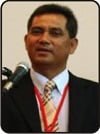Teaching Game for Understanding in Physical Education: A Theoretical Framework and Implication
Abstract
ABSTRACT: The primary purpose of the present study was to investigate the effects of Teaching Games for Understanding (TGfU) approach to improve students’ learning outcome of tactical game performance in physical education. By applying the constructivism learning theory, the study wants to investigate whether the students learning outcome in tactical game performance can be improved with the TGfU approach. The participants in this study were 10 years old primary physical education students. The Game Performance Assessment Instrument (GPAI) was used to measure students' tactical understanding of game performance. The results of the validation studies showed that the instruments developed for the purposes of this project were valid indicators of tactical game performance. The ANCOVA results revealed that there was a significant difference between the students who were exposed to TGfU approach and students with traditional skill approach on the post-test (F [1, 69] = 248.83, p < .05). This result indicated that the experimental group with TGfU approach has significant main effects on student learning outcome compared to the traditional skill approach. The findings of this study showed that constructivism theory improved primary physical education students learning outcome in physical education.
KEY WORD: Teaching games for understanding, constructivism, tactical understanding, and primary physical education.



About the Authors: Malathi Balakrishnan is a Doctoral Candidate at the Department of Mathematics and Science Education, Faculty of Education UM (University of Malaya), Kuala Lumpur, Malaysia; Shabeshan Rengasamy, Ph.D. is a Senior Lecturer at the Department of Mathematics and Science Education, Faculty of Education UM; and Assoc. Prof. Dr. Mohd Salleh Aman is Director of Sport Centre at UM. They can be reached at: malathi@siswa.um.edu.my, shabesh@um.edu.my, and amanms@um.edu.my
How to cite this article? Balakrishnan, Malathi, Shabeshan Rengasamy & Mohd Salleh Aman. (2011). “Teaching Game for Understanding in Physical Education: A Theoretical Framework and Implication” in ATIKAN: Jurnal Kajian Pendidikan, Vol.1(2) Desember, pp.201-214. Bandung, Indonesia: Minda Masagi Press owned by ASPENSI in Bandung, ISSN 2088-1290.
Chronicle of the article: Accepted (October 13, 2011); Revised (November 23, 2011); and Published (December 15, 2011).
Full Text:
PDFReferences
Allison, P.C. & K.R. Barrett. (2000). Constructing Children’s Physical Education Experience: Understanding the Content for Teaching. Boston, MA: Allyn & Bacon.
Blomqvist, M., P. Luhtanen & L. Laakso. (2001). “Comparison of Two Types of Instruction in Badminton” in European Journal of Physical Education, 6, pp.139-155.
Bunker, B. & R. Thorpe. (1982). “A Model for Teaching Games in Secondary Schools” in Bulletin of Physical Education, 18, pp.5-8.
Bunker, B. & R. Thorpe. (1986). “The Curriculum Model” in R. Thorpe, D. Bunker & L. Almond [eds]. Rethinking Games Teaching. Loughborough, UK: University of Technology, pp.7-10.
Butcher, C.A. & D.A. Wuest. (1999). Foundation of Physical Education and Sport. London, UK: McGraw-Hill, 13th edition.
Butler, J. & B.J. McCahan. (2005). “Teaching Games for Understanding as a Curriculum Model” in L. Griffin & J. Butler [eds]. Teaching Games for Understanding: Theory, Research, and Practice. Windsor: Human Kinetics, pp.33-35.
Cai, X.S. (1998). “Students Enjoyment of Physical Education Class in Three Teaching Style Environments” in Education, 118(3), pp.412-420.
Chen, W., I. Revegno & A. Iran-Nejad. (2002). “Application of a Whole Theme Perspective to Movements Approach for Teaching Physical Education in Elementary School” in Education, 123, pp.401-415.
Darst, P.W. & R.P. Pangrazi. (2006). Dynamic Physical Education for Secondary School Students. San Francisco, CA: Pearson Education, 5th edition.
De Vries, L.A. (2008). “Overview of Recent Innovative Practices in Physical Education and Sports in Asia” in Innovative Practices in Physical Education and Sports in Asia. Bangkok, Thailand: UNESCO, pp.1-21.
Dodds, P., L.L. Griffin & J.H. Placek. (2001). “Selected Review of Literature on Development of Learners Domain-Specific Knowledge” in Journal of Physical Education, 20, pp.301-313.
French, K.E. & S.L. McPherson. (2003). “Development of Expertise” in M. Weiss & L. Bunker [eds]. Developmental Sport and Exercise Psychology: A Lifespan Perspective. Morgantown, WV: Fitness Information.
Greihaigne, J.F. & P. Godbout. (1998). “Observation, Critical Thinking, and Transformation: Three Key Elements for a Constructivist Perspective of the Learning Process in Team Sports”. Paper presented at the 1998 AIESEP world conference in Long Island, Adelphi University.
Grehaigne, J.F., P. Godbout & D. Bounthier. (2001). “The Teaching and Learning of Decision Making in Team Sports” in Quest, 53, pp.59-76.
Griffin, L.L. & D.A. Sheehy. (2004). “Using the Tactical Games Model to Develop Problem‐Solvers in Physical Education” in J. Wright, D. Macdonald & L. Burrows [eds]. Critical Inquiry and Problem Solving in Physical Education. London, UK: Routledge, pp.33‐48.
Griffin, L.L. & J.H. Placek. (2001). “The Understanding and Development of Learners' Domain Specific Knowledge: Introduction” in Journal of Teaching in Physical Education, 20, pp.299-300.
Harvey, S., M. Wegis & H. Mars. (2006). Effects of Teaching Games for Understanding on Game Performance and Understanding in Middle School Physical Education Using Game Performance Assessment Instrument and Verbal Protocol Analysis. Oregon, USA: AAHPERD Research Grand Award, Oregon State University.
Holt, N., W. Stream & E.G. Begoechea. (2002). “Expanding the Teaching Games for Understanding Model: New Avenues for Future Research and Practice” in Journal of Physical Education, 21(2), pp.162-177.
Hopper, T. (2002). “Teaching Games for Understanding: The Importance of Student Emphasis Over Content Emphasis” in Journal of Physical Education, Recreation, and Dance, 73(7), pp.44-48.
Hopper, T. & D. Kruisselbrink. (2002). “Teaching Games for Understanding: What Does It Look Like and How Does It Influence Student Skill Learning and Game Performance?” in AVANTE, pp.1-29.
Jani, Julismah. (2000). “Masa Pembelajaran Akademik dan Pencapaian Pelbagai Kategori Keaktifan dalam Pendidikan Jasmani”. Unpublished Ph.D. Thesis. Serdang, Selangor: UPM [Universiti Pertanian Malaysia].
Jones, C. & D. Forrow. (1999). “Transfer of Strategic Knowledge: A Test of Games Classification Curriculum Model” in Bulletin of Physical Education, 35(2), pp.103-124.
Kaur, Abtar. (2001). “Design and Evaluation of a Web Based Constructivist Learning Environment for Primary School”. Unpublished Ph.D. Thesis. Kuala Lumpur, Malaysia: University of Malaya.
Kirk, D. & A. MacPhail. (2002). “Teaching Games for Understanding and Situated Learning: Rethinking the Bunker and Thorpe Model” in Journal of Teaching in Physical Education, 21, pp.177-192.
Lemlech, J.K. (1998). Curriculum and Instructional Methods for Elementary and Middle School. Upper Saddle River, NJ: Prentice Hall.
Light, R. (2002). “Engaging the Body in Learning: Promoting Cognition in Games through Teaching Games for Understanding” in ACHPER Healthy Lifestyle Journal, 49(2), pp.23-26.
Light, R. (2006). “Implementing Understanding Approach to Teaching Games and Sport in Asia” in Asian Journal of Exercise and Sport Science, 2(1), pp.39-48.
Mauldon, E. & H.B. Redfern. (1981). Games Teaching: An Approach for Primary School. London, UK: Macdonald & Evans.
Memmert, D. & S. Harvey. (2008). “The Game Performance Assessment Instrument: Some Concerns and Solution for Further Development” in Journal of Teaching in Physical Education, 27, pp.220-240.
Mezler, M.W. (2000). Instructional Models for Physical Education. Boston, MA: Allyn and Bacon.
Mitchell, S.A. (2005). “Teaching and Learning Games at the Elementary Level” in L. Griffin & J. Butler [eds]. Teaching Games for Understanding: Theory, Research, and Practice. Champaign, IL: Human Kinetics, pp.55-70.
Mitchell, S.A., J.L. Oslin & L.L. Griffin. (2006). Teaching Sport Skills: A Tactical Games Approach. Champaign, IL: Human Kinetics, 2nd edition.
MoE [Ministry of Education] Malaysia. (1998). Malaysian Physical Education Syllabus. Kuala Lumpur: Curriculum Development Centre, Ministry of Education.
MoE [Ministry of Education] Malaysia. (2001). Falsafah Pendidikan Kebangsaan: Matlamat dan Misi (National Philosophy of Education: Goals and Mission). Kuala Lumpur: Curriculum Development Centre, Ministry of Education.
Pangrazi, R.P. (2001). Dynamic Physical Education for Elementary School Children. Needham Heights, MA: Allyn & Bacon, 13th edition.
Pangrazi, R.P. & C.M. Casten. (2007). Dynamic Physical Education for Elementary School Children. San Francisco, CA: Cummings, 15th edition.
Piaget, J. (1973). The Child and Reality. New York, USA: Grossman, Translation.
Piaget, J. & B. Inhelder. (1969). The Psychology of a Child. New York, USA: Basic Books, Translation.
Piipari, S. et al. (2009). “Relationship between Physical Education Students’ Motivational Profiles, Enjoyment, State Anxiety, and Self-Reported Physical Activity” in Journal of Sport Science and Medicine, 8, pp.327-336.
Rengasamy, S. (2006). “The Current Status of Teaching Cardiovascular Endurance among Malaysian School Children: Theory and Practice” in Masalah Pendidikan, 29, pp.91-101.
Richard, J.F. & L. Griffin. (2003). “Authentic Assessment in Games Education: An Introduction to Team Sport Assessment Procedure and Game Performance Assessment Instrument” in J. Butler et al. [eds]. Teaching Games for Understanding in Physical Education and Sport. Oxon Hill: AAHPERD.
Richard, J.F. & N. Wallian. (2005). “Emphasizing Students Engagement in Construction of Game Performance” in L. Griffin & J. Butler [eds]. Teaching Games for Understanding: Theory, Research, and Practice. Champaign, IL: Human Kinetics, pp.19-32.
Rovegno, I. & J.P. Dolly. (2006). “Constructivism Perspectives on Learning” in D. Kirk, D. McDonald & May O’Sullian [eds]. Handbook of Physical Education. London, UK: Sage, pp.242-261.
Rovegno, I., M. Nevett & M. Babiaz. (2001). “Learning and Teaching Invasion Game Tactics in 4th Grade: Instructional and Theoretical Perspective” in Journal of Teaching Physical Education, 20(4), pp.341-351.
Salleh, A.R. (1997). “The Attitudes towards Physical Education of Students from Different Ethnic Groups at Secondary School Level in Malaysia”. Unpublished Ph.D. Thesis. Manchester, UK: University of Manchester.
Sanmuga, N. (2008). “The Effects and Sustainabilities of Training Programmes Using Teaching Games for Understanding (TGfU) with Different Teaching Style on Students with Varying Hockey Skill Levels”. Paper presented at 1st Asia Pacific Sport in Education Conference in Adelaide, Australia.
Sharifah, M. (2007). “Merintis Kurikulum ke Arah Membangun Modal Insan Gemilang”. Paper presented in the Persidangan Kurikulum Kebangsaan, Pusat Perkembangan Kurikulum, Kementerian Pelajaran Malaysia.
Tan, S. (2005). “Implementing Teaching Games for Understanding: Stories of Change” in L. Griffin & J. Butler [eds]. Teaching Games for Understanding: Theory, Research, and Practice. Champaign, IL: Human Kinetics, pp.107-124.
Thorpe, R.D. & D.J. Bunker. (1997). “A Changing Focus in Games Teaching” in L. Almond [ed]. Physical Education in School. London, UK: Kogan Page, pp.50-80.
Thorpe, R.D., D.J. Bunker & L. Almond. (1984). “A Change in the Focus of Teaching Games” in M. Pieron & G. Graham [eds]. Sport Pedagogy: Olympic Scientific Congress Proceeding, Vol.6. Champaign, IL: Human Kinetics, pp.163-169.
Turner, A.P. & T.J. Martinek. (1999). “An Investigation into Teaching Games for Understanding: Effects on Skill, Knowledge, and Game Play” in Research Quarterly for Exercise and Sport, 70, pp.286-292.
Webb, P. & P. Pearson. (2008). “An Integrated Approach to Teaching Games for Understanding”. Paper presented at 1st Asia Pacific Sport in Education Conference in Adelaide, Australia. Also being published in Journal of Health, Physical Education, Recreation & Dance, 67(1), pp.28-33.
Wee, E.H. (2001). “Attitude of Physical Education Teachers towards Physical Education and Implementation of Physical Education Program in Secondary School”. Unpublished Ph.D. Thesis. Kuala Lumpur, Malaysia: University of Malaya.
Wee, E.H. (2008). “Physical Education in Malaysia: A Case Study of Fitness Activity in Secondary School Physical Education Classes”. Paper presented in the Conference on Innovative Practices in Physical Education and sports in Asia, organized by UNESCO in Bangkok, Thailand, pp.22-43.
Werner, P. & L. Almond. (1990). “Model of Games Education” in Journal of Physical Education, Recreation, and Dance, 61(4), pp.23-27.
Werner, P., R. Thorpe & D. Bunker. (1996). “Teaching Games for Understanding: Evolution of a Model” in Journal of Physical Education, Recreation, and Dance, 67(1), pp.28-33.
Wuest, P.A. & C.A. Butcher. (2006). Foundation of Physical Education and Sport. New York: McGraw-Hill, 15th edition.
